Type a search term to find related articles by LIMS subject matter experts gathered from the most trusted and dynamic collaboration tools in the laboratory informatics industry.

A lowrider bicycle is a highly customized bicycle with styling inspired by lowrider cars.[1] These bikes often feature a long, curved banana seat with a sissy bar and very tall upward-swept ape hanger handlebars. A lot of chrome, velvet, and overspoked wheels are common accessories to these custom bicycles.[1]

The bikes are typically a highly individualized creation. Early modified bikes have been crafted as a part of lowrider culture by Chicano youth since the 1960s.[2][3] They were at first stigmatized by mainstream U.S. culture, even as they were a symbol of pride in Chicano communities.[4] They later became accepted and popular elsewhere.[5]
Lowrider Bicycle was a magazine dedicated to the bikes first published in 1993.[5] The bikes are now popular internationally, such as in Japan and Europe.[5] Despite the fact that these bikes originated within the poverty of the barrio, lowrider bikes can be expensive.[6] Some of the bikes are not rideable and exist only for aesthetic purposes.[7]
| Part of a series on |
| Chicanos and Mexican Americans |
|---|
 |
Early modified bikes first appeared in California alongside Lowrider car culture popular in Chicano communities.[5][8] Mexican American youth would emulate the craft of lowrider cars with their bicycles as a canvas for creativity, usually starting with common muscle bikes. This allowed those who were too young to drive a car to have a custom vehicle.[3][9][10][11] Similar to lowrider cars, the bikes were stigmatized as a part of "gang culture" by mainstream America simply because of their origins within the Chicano community.[2][4][11]
In 1963, the Schwinn company released of the Schwinn Sting-Ray.[12] George Barris, who moved to Los Angeles to "become part of the emerging teen car culture" opened a shop in Bell, California, a Mexican American neighborhood.[13] He used the Schwinn stock frame to create a modified bike for The Munsters set in the mid-1960s.[5] This bike had a chain body to fit the macabre style of the show, but did not have an elongated body.[14] This was for the character Eddie Munster, yet the bike did not appear on the show and was largely unknown at the time.[15] In the 1990s, Lowrider Bicycle magazine used this bike to "effectively creat[e] an origin myth for the lowrider bicycle movement."[14]
The lowrider bicycle with an elongated body and stylistic flare has sometimes been credited to Joe Manny Silva, who worked on bikes out of his shop when he emigrated to the U.S. from Mexico and opened a shop in Compton, California in 1973.[16][17] He had worked on bikes since he was ten.[18] His bikes were featured in prominent music videos and films.[19] Some have referred to Silva as the "Godfather of Lowrider Bicycles" because of his long history in the community and his influence in expanding the lowriding bike scene,[16][17][18] despite bike modifications being around among Mexican American youth prior.[2][9][10]

Throughout the 1970s and 80s, lowrider bikes were featured alongside lowrider cars in shows.[5] The club Rollerz Only was founded in 1988 in Los Angeles and grew to 42 chapters worldwide over time.[20] Lowrider bicycles surged in popularity in the 1990s, as competition over style and design became intense.[5] With the increased popularity, classic Schwinns, which became the body of choice as a starting base to create unique designs and modifications,[18] were far more scarce and more expensive. Stemming from this new popularity, a magazine titled Lowrider Bicycle started publication in 1993 as an offshoot of Lowrider Magazine.[5]
In the 1990s, Alberto Lopez, who was a publisher at the magazine, crafted the Aztlan Cruiser bike.[21] The first bike to be featured on the cover of the magazine was known as "Claim Jumper" and owned by Danny Galvez, Jr. of Los Angeles, California.[21] The bike elevated standards for crafting of lowrider bikes throughout the country: "everyone started slamming their bikes by bending their forks as radically as possible to give the bikes that old school flavor."[21]
In the 1990s, bike mechanic and designer Warren Wong, who worked with BMX bikes, became a pioneer in lowrider bicycle history with his wheel design.[21] He became known as the "Wheel King" and crafted a unique clover-laced design which became known as his "Body Count."[21] These were an important development in lowrider wheels that were later duplicated by others.[21]
In the late 1990s, popular American advertisements by various corporations began to use the bikes in ads in order to capitalize on its popularity.[21] This expanded the bike's notoriety further, pushing its reach internationally.[21] The Lowrider Bicycle magazine expanded its reach and became more popular.[21]

In 1996, the documentary "Low y Cool" was created on the lowrider bike scene in Tucson, Arizona.[22] It challenged the violent Hollywood image portrayed of Chicano youth in films like “Blood in, Blood out,” “American Me” and “Mi Vida Loca."[22] In 2000, the bikes were featured in Chicano techno artist DJ Rolando's video for "Knights of the Jaguar," which showed various portraits of Chicano life in Detroit.[23]
The Los Chilangos lowriding bicycle club of Mexico City formed in 2014.[3][24] In a story on the group, one photographer who followed the group credited the importance of the Chicano culture in bridging lowriding bike culture across the border and expanding its popularity in Mexico.[3]
The bikes are still featured in advertisements as of 2022 and remain an important cultural symbol of pride for Chicanas and Chicanos.[25] A article for The Daily Chela by Brandon Loran Maxwell noted that there is a resurgence of lowrider bicycles occurring.[25]
Some makes of bicycles are particularly popular among lowrider builders.

Basic or classic characteristics of a lowrider bike (most accessories are highly polished chrome, though gold can also be used for added flare):
Some custom modifications include twisted forks, spokes or handlebars, what are known as "bird cages" (twisted metal strips that resemble a bird cage) that are cut and welded onto handlebars, sissy bars or pedals. Many bikes also feature custom framework such as tanks and skirts which are the addition of sheets of metal, usually welded onto the frame to give it a "filled-in" look. Some lowrider bicycles even have air or hydraulic cylinders set-up to emulate the height adjustable suspension of lowrider motor cars.
One American bicycle mechanic Sheldon Brown wrote:
they are built purely as an exercise in styling, with no real concern for riding qualities. Some of them, in fact, are not rideable, because the cranks are so close to the ground that the pedals cannot turn around."[26]
Some lowrider bikes are modified into lowrider tricycles, for style. Converting a lowrider bicycle into a tricycle often allows the bike to sit closer to the ground while still being rideable, and even hop without falling over if they have airbag suspension or hydraulic suspension. Converting a bicycle into a tricycle often creates extra carry-space at the back of the bike.
The space between the two rear wheels is sometimes used to mount either a two-seater "love seat", a "boombox," or even pumps for hydraulic or air suspension.
Commercially bolt on conversion kits to convert any existing lowrider bicycle into a tricycle are available from many sources.

Lowrider Bicycle (LRB) magazine (published by Lowrider), debuted in the winter of 1993, bringing the culture of lowrider bicycle to mainstream America.[27]
LRB notable moments:[27]

In 1992, the Beastie Boys mentioned Lowrider bicycles in their song "Professor Booty", on the album "Check Your Head".
In 1994, the AirWalk shoe company made a commercial featuring lowrider bikes.[28]
In 1996, Marianne Dissard and Robert Kramer made the documentary film Low y Cool with the South Tucson, Arizona, lowrider bicycle club Los Camaradas.[29]
Also in 1996, as part of Kodak's Advantage camera systems advertising campaigns, the company shot Rene Vargas and his "Gangster Madness" bike (featured on the Nov./Dec. '95 issue of LRB) for a nationwide commercial, which debuted during the 1996 Summer Olympics.[27]
This was the beginning for more usage of lowrider bikes in commercials, as the industry loved the lifestyle involved with the bikes and wanted to capitalize on the hot youth trend.[27]

In 2000, Sprite shot a television commercial focusing on the youth of lowriding, which featured four-time LRB Bike of the Year Champion Mike Lopez, Jr. and his club, Finest Kreations. (After "retiring," Lopez, Jr. also traveled to Europe to display his bike in a cultural exhibition.)[27]
In 2001, PepsiCo made a commercial titled What's Your Thirst.[30]
In 2022, the bikes were featured in a 7-Eleven commercial.[25]
Lowrider bicycles are a fad design of bicycles, inspired by the wheelie bikes of the 1960s with very long wheelbases.
{{cite book}}: CS1 maint: location missing publisher (link) CS1 maint: others (link)
{{cite web}}: CS1 maint: multiple names: authors list (link)
the introduction of the 1963 Schwinn Sting-Ray bicycle, which continues to be extremely popular among urban Chicano youth
Lowrider bikes, which often feature long bodies with high handlebars and curved banana seats, appeared in Los Angeles and other cities in the 1960s, alongside the cars seen as a reflection of Chicano or Mexican-American culture.
Trying to emulate lowrider automobiles, Chicano children started to personalize old cruiser bicycles into "Lowrider Bicycles."
Kids who watched the "Munsters" in the 1960s never got to see Eddie's chain bike, and only a few insiders knew anything about the chain bike story until about ten years ago.